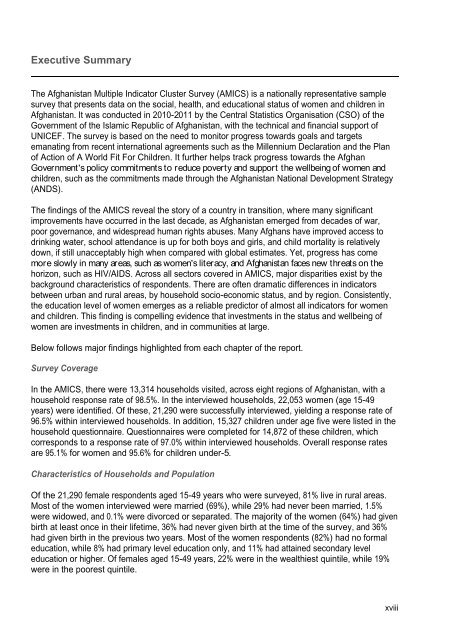Microsoft Word - AMICS-29Jan2013 - Childinfo.org
Microsoft Word - AMICS-29Jan2013 - Childinfo.org
Microsoft Word - AMICS-29Jan2013 - Childinfo.org
Create successful ePaper yourself
Turn your PDF publications into a flip-book with our unique Google optimized e-Paper software.
Executive Summary<br />
The Afghanistan Multiple Indicator Cluster Survey (<strong>AMICS</strong>) is a nationally representative sample<br />
survey that presents data on the social, health, and educational status of women and children in<br />
Afghanistan. It was conducted in 2010-2011 by the Central Statistics Organisation (CSO) of the<br />
Government of the Islamic Republic of Afghanistan, with the technical and financial support of<br />
UNICEF. The survey is based on the need to monitor progress towards goals and targets<br />
emanating from recent international agreements such as the Millennium Declaration and the Plan<br />
of Action of A World Fit For Children. It further helps track progress towards the Afghan<br />
Government s policy commitments to reduce poverty and support the wellbeing of women and<br />
children, such as the commitments made through the Afghanistan National Development Strategy<br />
(ANDS).<br />
The findings of the <strong>AMICS</strong> reveal the story of a country in transition, where many significant<br />
improvements have occurred in the last decade, as Afghanistan emerged from decades of war,<br />
poor governance, and widespread human rights abuses. Many Afghans have improved access to<br />
drinking water, school attendance is up for both boys and girls, and child mortality is relatively<br />
down, if still unacceptably high when compared with global estimates. Yet, progress has come<br />
more slowly in many areas, such as women s literacy, and Afghanistan faces new threats on the<br />
horizon, such as HIV/AIDS. Across all sectors covered in <strong>AMICS</strong>, major disparities exist by the<br />
background characteristics of respondents. There are often dramatic differences in indicators<br />
between urban and rural areas, by household socio-economic status, and by region. Consistently,<br />
the education level of women emerges as a reliable predictor of almost all indicators for women<br />
and children. This finding is compelling evidence that investments in the status and wellbeing of<br />
women are investments in children, and in communities at large.<br />
Below follows major findings highlighted from each chapter of the report.<br />
Survey Coverage<br />
In the <strong>AMICS</strong>, there were 13,314 households visited, across eight regions of Afghanistan, with a<br />
household response rate of 98.5%. In the interviewed households, 22,053 women (age 15-49<br />
years) were identified. Of these, 21,290 were successfully interviewed, yielding a response rate of<br />
96.5% within interviewed households. In addition, 15,327 children under age five were listed in the<br />
household questionnaire. Questionnaires were completed for 14,872 of these children, which<br />
corresponds to a response rate of 97.0% within interviewed households. Overall response rates<br />
are 95.1% for women and 95.6% for children under-5.<br />
Characteristics of Households and Population<br />
Of the 21,290 female respondents aged 15-49 years who were surveyed, 81% live in rural areas.<br />
Most of the women interviewed were married (69%), while 29% had never been married, 1.5%<br />
were widowed, and 0.1% were divorced or separated. The majority of the women (64%) had given<br />
birth at least once in their lifetime, 36% had never given birth at the time of the survey, and 36%<br />
had given birth in the previous two years. Most of the women respondents (82%) had no formal<br />
education, while 8% had primary level education only, and 11% had attained secondary level<br />
education or higher. Of females aged 15-49 years, 22% were in the wealthiest quintile, while 19%<br />
were in the poorest quintile.<br />
xviii

















